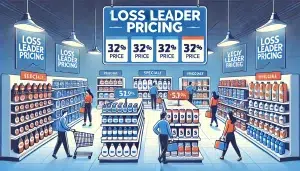
Inflationary pressures are reshaping consumer behavior, and maintaining competitive pricing is crucial for retail success. Walmart, one of the world’s largest retailers, has mastered this through its everyday low price strategy. This approach distinguished Walmart from its rivals, fostered customer loyalty, streamlined costs, and significantly boosted sales.
For instance, Walmart’s online sales surged from $15.7 billion in 2019 to $53.4 billion in 2023, demonstrating the effectiveness of its pricing model. This article will examine Walmart’s everyday low price strategy and provide insights on how other retailers can adopt similar tactics to enhance their value proposition.
What is the Everyday Low Price Strategy?
The everyday low price strategy is a pricing approach where a retailer maintains a consistently low price on products rather than relying on periodic sales, promotions, or discounts to attract customers. Unlike high-low pricing strategies that alternate between high regular prices and significant discounts during sales events, everyday low price assures consumers that they always get the best possible price without waiting for a special promotion.
Walmart pioneered the everyday low price strategy 1962, a cornerstone of its business model. The strategy is built on offering “always low prices,” which appeals to budget-conscious shoppers and simplifies the shopping experience. Customers don’t have to worry about comparing prices between different times or competing stores—they know they get a good deal at Walmart whenever they shop.
This consistency in pricing creates several benefits for both the retailer and the consumer:
1. Consumer Trust and Perceived Value
By offering low prices daily, Walmart cultivates a perception of value and fairness among its customers. Shoppers develop trust in Walmart, knowing they don’t need to hunt for bargains or time their purchases to get the best deals. This reliability in pricing encourages repeat business and strengthens customer loyalty.
2. Simplified Pricing and Inventory Management
For Walmart, everyday low prices simplify pricing across thousands of products, reducing the complexity of managing price fluctuations tied to promotions. This allows for better forecasting, inventory management, and supply chain optimization since demand is steadier compared to the spikes seen during promotional events.
3. Operational Efficiency
Everyday low price also supports operational efficiency. Since prices are stable, Walmart can streamline its operations, from procurement to shelf-stocking, minimizing the disruptions that frequent price changes can cause. This efficiency translates into cost savings, which Walmart passes on to customers through lower prices.
4. Competitive Edge
The everyday low price strategy gives Walmart a competitive advantage by distinguishing it from retailers that rely on high-low pricing. Shoppers attracted to consistent value tend to prefer Walmart over competitors that may offer occasional deals but generally maintain higher prices.
Overall, EDLP is a customer-centric strategy that aligns Walmart‘s pricing with consumer expectations of value and convenience. This makes it a powerful tool in driving long-term customer satisfaction and loyalty. This approach has been instrumental in Walmart’s rise to becoming one of the world’s largest and most successful retailers.
How Walmart’s Everyday Low Price Strategy Powers Its Online Marketplace
Walmart’s success in the online marketplace is significantly driven by its everyday low price strategy, which operates on several core principles:
1. Lower Operational Costs through Scale
Walmart leverages its vast scale to offer prices that undercut competitors like Amazon. By driving high sales volumes, Walmart reduces per-unit operational costs, creating a virtuous cycle of cost savings and increased sales.
2. Direct Sourcing for Cost Efficiency
One of the pillars of Walmart’s EDLP strategy is direct sourcing. By negotiating directly with manufacturers and cutting out intermediaries, Walmart can secure products at lower costs, which it passes on to customers at lower prices. This direct relationship also allows for better control over product quality and supply chain reliability.
3. Private Label Power
Walmart‘s investment in private label brands like Great Value and Equate gives it a competitive edge. These in-house brands provide consumers cheaper alternatives to name-brand products while ensuring higher margins for Walmart. The popularity of these brands further solidifies Walmart’s reputation as a low-price leader.
4. Optimized Supply Chain and Bargaining Power
Walmart’s sophisticated supply chain management and immense bargaining power enable it to negotiate favorable terms with suppliers. This ensures that Walmart can maintain its low prices even as market conditions fluctuate, reinforcing its everyday low price strategy.
Is an Everyday Low Price Strategy Right for Your Business?

Before adopting an EDLP strategy, it’s crucial to evaluate several factors to ensure it aligns with your business model:
1. Understanding Your Customer Base
Everyday low price strategies are particularly effective with price-sensitive customers who prioritize value. If cost considerations drive your customer base, implementing EDLP can help attract and retain these shoppers.
2. Analyzing Competitive Landscape
If your competitors are focused on high-low pricing models with frequent promotions, an everyday low price strategy can differentiate your business by offering consistent value. However, if competitors are also using EDLP, additional factors such as brand strength and operational efficiency will play a critical role in your success.
3. Assessing Profit Margins
EDLP typically requires lower profit margins, making it essential for businesses to achieve operational efficiencies and cost reductions elsewhere. This strategy is most viable for retailers with the ability to scale operations and maintain tight control over costs.
4. Strengthening Supply Chain Capabilities
A robust and responsive supply chain is vital for sustaining an everyday low price strategy. If your supply chain lacks the flexibility or efficiency required to offer low prices consistently, the strategy might not be suitable.
5. Aligning with Long-term Business Goals
EDLP is a long-term commitment. If your business model focuses on immediate financial returns, it might conflict with short-term profitability objectives. It’s essential to weigh the long-term benefits against immediate financial needs.
How Pricefy Can Help You Monitor Walmart Prices and Stock

Pricefy offers robust capabilities for monitoring Walmart‘s prices and stock levels, providing you with real-time data to inform your pricing decisions.
Here’s how Pricefy can give you a competitive edge:
- Real-Time Price Tracking: Pricefy allows you to monitor Walmart’s prices for specific products or categories in real-time. This enables you to quickly adjust your own prices to remain competitive or maintain your desired price position relative to Walmart.
- Stock Level Insights: By tracking Walmart’s stock levels, you can identify opportunities when products are out of stock at Walmart and potentially capture those sales by ensuring you have inventory available.
- Historical Data Analysis: Pricefy provides historical pricing data, allowing you to identify trends in Walmart’s pricing strategies. This can help you anticipate future price changes and plan your own pricing moves accordingly.
- Automated Alerts: Set up custom alerts for price changes or stock status updates on key products at Walmart. This ensures you’re always aware of significant changes in the competitive landscape.
- Competitive Benchmarking: Compare your prices not just against Walmart, but also other competitors in your market. This holistic view helps you position your prices optimally within the broader competitive landscape.
- Dynamic Repricing: Utilize Pricefy’s dynamic repricing capabilities to automatically adjust your prices based on changes in Walmart’s pricing or stock levels, ensuring you maintain your desired competitive position.
- Data-Driven Decision Making: Leverage Pricefy’s analytics and reporting features to make informed decisions about your pricing strategy, product assortment, and inventory management.
By harnessing the power of Pricefy, you can implement a more responsive and data-driven approach to penetration pricing or everyday low price strategies.
This allows you to compete more effectively with retail giants like Walmart, even if you don’t have their scale or resources.
How to Implement Walmart’s Everyday Low Price Strategy in Your Business

If you’ve decided that the Everyday Low Price (EDLP) strategy aligns with your business goals, there are several key steps to implement it successfully. Each step is crucial in offering consistently low prices while maintaining profitability and operational efficiency.
1. Direct Sourcing for Cost Efficiency
Direct sourcing is fundamental to the EDLP strategy. It involves establishing direct relationships with manufacturers, which allows you to negotiate better prices by cutting out intermediaries. This reduces costs and provides greater control over product quality and supply chain logistics.
For example, Walmart sources many of its products directly from manufacturers, enabling them to purchase in large quantities at lower prices, which they then pass on to customers. Businesses looking to adopt EDLP should seek to build strong partnerships with manufacturers, negotiate favorable terms, and explore opportunities for bulk purchasing.
Action Steps:
- Identify key suppliers and initiate direct negotiations.
- Explore long-term contracts with manufacturers for better pricing stability.
- Consider international sourcing if it offers cost advantages without compromising quality.
2. Develop Private Labels to Enhance Margins
Introducing private-label products is another effective way to support an EDLP strategy. Private labels are store brands that typically cost less than national brands because they eliminate the markup from brand manufacturers.
Walmart‘s private labels, such as Great Value and Equate, have offered lower-priced alternatives while ensuring healthy profit margins. Developing your private label allows you to offer exclusive products that can be priced competitively, further strengthening your EDLP promise.
Action Steps:
- Research market demand for potential private label categories.
- Work with manufacturers to develop products that meet your quality and cost standards.
- Invest in branding and marketing to build customer trust in your private label offerings.
3. Optimize Operational Costs for Greater Savings
Cost optimization is critical to sustaining low prices. Efficient supply chain management, lean inventory practices, and cost-saving initiatives are essential to keep operational costs low.
Walmart has mastered supply chain efficiency, using advanced logistics and technology to minimize waste and reduce overhead. By streamlining operations, your business can lower expenses and pass those savings on to customers without sacrificing profitability.
Action Steps:
- Implement inventory management systems that reduce excess stock and prevent over-ordering.
- Streamline your supply chain by consolidating suppliers and optimizing transportation routes.
- Explore technology solutions to automate processes and reduce labor costs.
4. Leverage Bargaining Power to Secure Better Deals
Even if your business is smaller than Walmart’s, you can still leverage bargaining power by pooling resources or partnering with other retailers to negotiate better terms with suppliers.
The idea is to maximize your purchasing power to obtain discounts or favorable terms that help you maintain low prices. For example, small businesses can join buying groups or cooperatives to increase their collective bargaining strength.
Action Steps:
- Join or form purchasing alliances with other businesses in your industry.
- Negotiate bulk purchasing deals or longer payment terms with suppliers.
- Regularly review supplier contracts to identify opportunities for renegotiation.
5. Consider Shrinkflation as a Pricing Tactic
Shrinkflation involves reducing the size or quantity of a product while maintaining its original price. This tactic allows you to manage rising costs without overtly increasing prices, thus keeping your EDLP promise intact.
While shrinkflation can be controversial if not managed transparently, it can be an effective way to navigate cost pressures, especially in inflationary environments.
Action Steps:
- Analyze product lines to identify items where shrinkflation could be implemented with minimal consumer backlash.
- Communicate any changes to product sizes to maintain customer trust.
- Use shrinkflation selectively, focusing on products where size reductions are less likely to impact customer satisfaction.
Wrapping Up
Walmart’s Everyday Low Pricing (EDLP) strategy has been a cornerstone of its dominance in the retail sector. By consistently offering low prices, Walmart has built a loyal customer base, reduced operational costs, and significantly grown its online marketplace.
Retailers looking to replicate this success should carefully assess their customer base, competitive landscape, and supply chain capabilities. Adopting an EDLP strategy could be a powerful tool in maintaining customer loyalty and driving sales in a competitive marketplace.
To further enhance the effectiveness of your pricing strategy, using a tool like Pricefy can provide valuable insights and dynamic repricing capabilities, helping you stay competitive and responsive to market changes.




